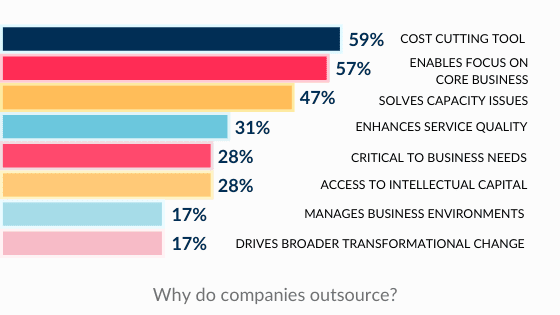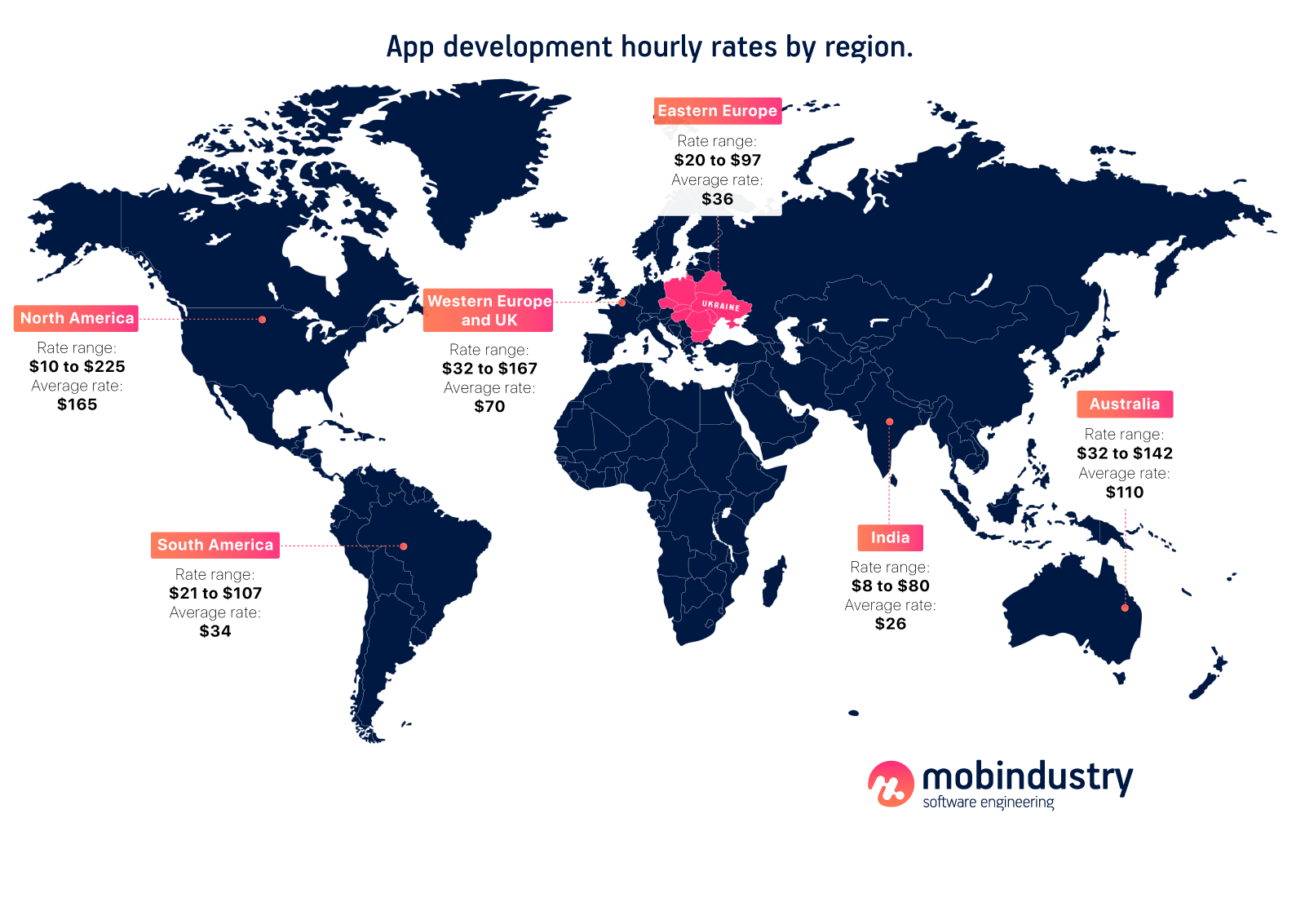Month: July 2022
Best Practices to Successfully Outsource Your Web Development Project
Why do companies outsource web development?
Large businesses have been outsourcing development for a long time. But technological progress has now made it affordable for small businesses too. A 2019 study by Avasant shows that 55% of companies outsource app development.
Though reasons for outsourcing differ from industry to industry, Deloitte finds there are three main reasons why companies choose outsourcing:
- Cost savings (59% of companies)
- Desire to focus on core competencies (57% of companies)
- Solve performance problems (47% of companies)
The ability to access intellectual capital is another reason why companies choose to outsource web and software development.
Outsourcing provides access to a larger pool of talent while allowing entrepreneurs to cut labor costs. One of the best options for an entrepreneur is to choose a web development outsourcing company that will build their product professionally. When the web project is ready and live, they can then hire an in-house team to manage it.
Benefits of outsourcing web development
Here’s a list of the main benefits of outsourcing web development:
Save money
The cost savings of outsourcing software development is one of the main advantages for small businesses. In addition to favorable rates of web development outsourcing services in some countries, an outsourcing team doesn’t need to be hired and trained.
With outsourcing, you don’t need to hire an HR manager and office manager, pay rent, or buy equipment and furniture.
Get access to a large pool of talent
Don’t think that the only reason companies choose outsourcing is the cost. It’s also about finding the best professionals that can bring the project to life. Outsourcing web development allows you to find precisely those specialists for your project needs by giving you access to a large pool of talented specialists.
Scale your project
Outsourcing web development allows you to scale your project faster.
Outsourcing companies have experience scaling and can add more specialists to a development team if necessary. When you have your own in-house team, each new specialist requires lots of resources.
Reduce risks and stress
Outsourcing allows you to have a development team led by a project manager who mitigates development risks. A project manager is responsible for planning the project, communicating with the client, and solving internal problems. No matter what, an outsourcing development team has time limits and restrictions and is obliged to follow the contract.
Secure your project
IT outsourcing companies usually sign non-disclosure agreements (NDAs) with their clients, use secure Gitlab repositories, and choose reliable hosting services. This way you can be sure your project and web design idea are safe.
Focus on your core competencies
Outsourcing software development lets you focus on generating profit. Outsourcing gives you the opportunity to fully commit yourself to web design, user experience, marketing, sales, testing business hypotheses, and other important business processes.
After choosing an outsourcing company, you should settle on the project lifecycle and set time frames.
As a client, you only need to approve of your team’s work and comment on it.
Speed up process organization and development
Outsourcing software development lets you focus on marketing and sales. It also offers access to new technologies that you’re otherwise unlikely to get access to. Outsourcing accelerates organizational and developmental processes thanks to the fact that outsourcing development teams work according to a development methodology. Because of this, your project will be created fast, efficiently, and with minimal changes.
| Pros of outsourcing | Cons of outsourcing |
| Cost savings | Language difference |
| Talent acquisition | Travel costs |
| Tax savings | Soft factory |
| Time-saving opportunities | Technology gap |
| Quality | Risks |
5 Biggest Outsourcing Mistakes to Avoid
1. Outsourcing of functions directly related to the client
Brief definition: execution “affects” the client, but indirectly; for example, resolving a customer complaint directly concerns the customer himself. Some companies outsource their customer service functions with less than outstanding results. Small businesses cannot afford anything other than outstanding results. When it comes to customer – sales, customer service, answering calls or emails – leave that at home.
2. Reassessing savings
Outsourcing never saves as much time and money as you hope. At the very least, relationship management itself takes time: enforcing standards, measuring performance and providing feedback, answering questions, intervening in unusual situations, etc. Usually, you are expected to achieve 70% of the planned result at best. … saving. If possible, you better enjoy a pleasant surprise.
3. Lack of leadership
Outsourcing can make sense when a process or task can be defined through guidelines, procedures, and rules. The problem is that many companies do not take the time to create these comprehensive guidelines, procedures, and rules. Think of it this way: If you already have written instructions and procedures for your internal process, assume that you need to provide at least twice as much documentation to your outsourcing partner. In most enterprises, many instructions and practices are not written. With outsourcing, everything must be done in writing. Whatever you assume, needless to say needs to be said.
4. Jumping in too fast
It is tempting to outsource the entire process to an outsourcing partner immediately. (Sometimes this is the only way to financially justify a project.) Even so, don’t do it. Move slowly. Think of the early stages as a honeymoon period, as great experiences can turn into something completely different over time. Transfer part of the function and let your outsourcing partner get a larger share.
5. Inability to take measurements on site
Outsourcing naturally takes processes out of sight. Without measurement systems, these processes are also meaningless. Determine how you will measure performance against standards, carefully measure performance against standards, and go one step further than metrics by periodically sampling your outsourcing partner’s performance. Play mystery shopping and ask others to experience the process firsthand to share their findings. Trust – but always check.
How to outsource web development
You should avoid making hasty decisions when considering an outsourcing company. It’s important to learn the steps required to outsource web development services. To understand how outsourcing works, you should study its structure. Here are the seven main steps to successfully outsourcing web development:
Step 1. Establish your goals
The first thing you need to do before hiring an outsourcing company is to establish your goals and define your project’s needs. Uncertain expectations will lead to wasted time and money.
Start by writing a description of your web project. Answer the following questions: What is my goal for my project? What are the project’s needs?
Step 2. Specify the project requirements
The next step is to think through your business goals and technical requirements for your web outsourcing project. Answer these questions as precisely as possible:
- What are my business goals?
- What are the technical requirements for my project?
- What technology stack would I like to use?
Don’t hesitate to reveal all of your project’s functionality. This can help your prospective outsourcing team understand your idea and estimate the software development budget and timing. It will also help you learn how to outsource your web development tasks within a reasonable budget, as working on your scope of features and sprints usually means removing unneeded features before development begins.
Step 3. Calculate the budget and project time frame
Each region has different pricing for web development services. Your estimated budget will help you choose the region that suits you best.
Note that it’s important not to hire the first vendor with the lowest price.
Set your budget and decide what you expect from your outsourcing web development company.
You should also clarify the duration of the project. Here are two main questions you should answer:
- How much am I willing to pay for outsourcing the development of my project?
- When do I expect my project to be delivered?
Step 4. Choose the type of outsourcing
There are three basic types of outsourcing:
1. Onshore outsourcing
Onshore outsourcing is when a client hires a web development outsourcing service located in the client’s own country or region. By outsourcing to a local company, you can forget about language and cultural barriers. But when you have a limited budget, an onshore outsourcing web development company isn’t the best way to go. As the cost of web development will be rather high, you’ll likely encounter difficulty in building marketing and sales processes without offshore outsourcing. Onshore web development outsourcing can promise good enough quality, but nearshore and offshore outsourcing open up way more benefits.
2. Nearshore outsourcing
Nearshore outsourcing means working with a company located in the same time zone. One of the main benefits of nearshore outsourcing is that the client and the outsourcing service provider share the same culture and language. Compared to onshore outsourcing, nearshore outsourcing can save you money during development, which will speed up business processes.
3. Offshore outsourcing
Offshore outsourcing means the client hires a website developers or outsourcing team from a foreign country. In this case, it’s very likely that the client and employees of the offshore web development outsourcing company will speak different languages and not share the same culture. However, most offshore outsourcing web development companies speak English.
Outsourcing to an offshore web development company allows you to gain access to the largest pool of talented professionals without spending too much money. It also helps speed up all ongoing processes.
Consider these types of IT outsourcing and choose the one that best suits your needs and business goals.
Step 5. Make a list of potential web development outsourcing providers
Now that you know what type of outsourcing suits your business needs, you can start looking for a web development provider. For this, you can use platforms like Clutch.co, or you can ask your business network for advice. Based on your research and recommendations, compile a list of web development companies you might like to work with. Your list should have about 10 to 15 outsourcing candidates that have good reputations and can meet both your expectations for web development and the project’s needs.
Mobindustry is listed among the best developers in Ukraine in the latest Clutch report!
Step 6. Prepare questions for interviewing potential software providers
Now that you’ve selected candidates for outsourcing software development to, try to gather as much detail about them as possible. The most effective way to choose a software development outsourcing company is through a video interview. Prepare questions for outsourcing company interviews in advance.
Below, we list the main factors you should consider while interviewing an outsourcing development company:
- Experience. Ask a company’s representative if they’ve had a project similar to yours and if they’ve worked in your industry before.
- Years on the market. Ask for how long the company has been providing its services and how long they’ve been providing web development outsourcing services.
- Portfolio. Ask to see projects the company has already created as an outsourcing web development provider.
- Technology stack. Does the company have experience with the technologies required for your project? Check the technology stack and capabilities of your potential supplier.
- Feedback. Read feedback from previous clients. Pay attention to what they say about the team’s work and the results of cooperation.
- Team. Ask about team members’ skills and experience.
- Internal workflow. Ask company representatives about the methodologies they use for web projects and what support they provide. Find out how the company conducts quality control and corrects errors when creating products.
- Communication. Remember that communication is very important when it comes to outsourcing web development. Make sure your team’s project leader is fluent in English. Ask how the company arranges communication between clients and project managers.
- Security. Ask your potential outsourcing vendor about the security measures they take to protect projects. Make sure the company is willing to sign a non-disclosure agreement. Also, don’t forget to ask about payment methods.
A good outsourcing web development company will ask you to look at all your project specifications to offer you the best solution. Write down the answers that will help you with the screening process.
Step 7. Choose a web development outsourcing company
Once you choose an outsourcing development company, you should create a contract. It should include the services to be provided, the timing of their provision, and payment details. Establish clear conditions for the provision of web development outsourcing services both for individual parts of the work and for the entire project. Indicate results and milestones. Discuss terms and payment methods.
To avoid any leakage of private data, insist on signing an NDA.
Step 8. Ensure efficient communication
The most important part of outsourcing development is good communication. If you’re worried about time differences, don’t hire an inexperienced team. Experienced companies know how to ensure smooth communication and adjust their schedules to suit your time zone while outsourcing web development. When choosing to outsource web development, consider time and scheduling differences to ensure effective communication. You can use text chats or video chats in tools such as Slack, Skype, or Zoom.
Experienced teams work under the supervision of a project manager who reports to you with updates. Make sure that you and your outsourcing development team are on the same page. This will help to reduce the number of errors and revisions in the software development process as well as to eliminate additional costs and misunderstandings.
Once the workflow is in place, you can take advantage of outsourcing the software development lifecycle and focus on your core competencies
How much does it cost to outsource web development?
Let’s find out how the cost of software or web development projects is formed. The cost of outsourcing web development depends on these factors:
- Features
- Design
- Hourly rate of your development team
- Project size and complexity
- Technology stack
- Number of team members on the project
- Time frame
The biggest factor that influences a project’s cost is the hourly rate of developers, and that often depends on location. For example, an application that costs $40,000 to build in the US will cost around $9,000 if developed by engineers in Ukraine.

Developing your project with a company based in Eastern Europe is cost-effective and gives you access to top talent.
What does a web development outsourcing team look like?
A web development team should consist of at least the following roles:
- Project manager (PM). This is the person who’s in charge of product creation. A project manager controls the development process and reports to you. If you have any questions about your project, you should contact your PM.
- Backend developer. This is your key specialist for outsourcing software development. The backend developer is in charge of the server-side of the project.
- Frontend developer. This team member is in charge of the client side of your web project and links together coding and design. The frontend developer’s job is to bring to life designs of any complexity. They make sure that your web project looks right in different browsers, on different operating systems, and on all devices.
- Designer. This specialist is in charge of creating an attractive and convenient product for your customers. A highly skilled designer helps bring your idea to life and shows you what you want to see.
If you only need one or a couple of these specialists, pay attention to outstaffing services. Our engineers can integrate into your existing team and you can manage them remotely.
Quick summary of how to outsource a web development project
Here are the key takeaways:
- Outsourcing web development allows you to find precisely those specialists you need for your project. It gives you access to many more talented specialists than you can find locally.
- The first thing you need to do before hiring an outsourcing company is to establish your final goals and your project’s needs.
- Think through your business goals and technical requirements for an outsourcing web project.
- Set your budget and establish what you expect from an outsourcing web development company. You should also clarify the duration of the project.
- Choose the type of outsourcing: onshore, nearshore, or offshore.
- Make a list of potential web development outsourcing providers. For this, you can use platforms like Clutch.co or ask your business network for advice.
- Prepare questions for interviewing potential providers. Ask about a provider’s experience, portfolio, years on the market, technology stack, reviews, team, internal workflow, security, and communication.
- Once you choose an outsourcing development company, you should sign a contract. It should include the services to be provided, the timing of their provision, and payment details.
- The most important part of outsourcing is good communication.
- Developing your project with a company based in Eastern Europe is cost-effective and gives you access to top talent.
If you want to outsource your web development project or if you have any questions regarding this topic, contact Mobindustry for a free consultation.


